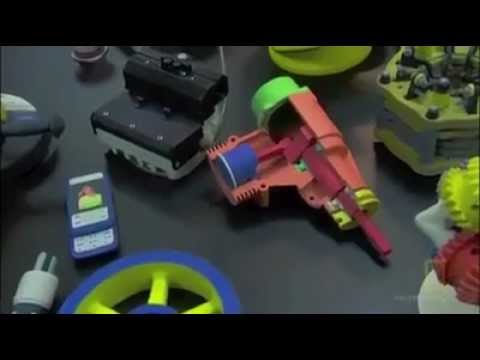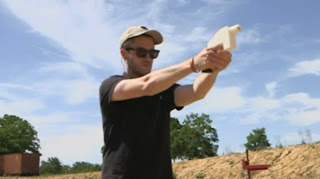

replicator (noun): a fictional technology from Star Trek:The Next Generation. This machine was capable of reproducing objects, originally seen synthesizing meals on demand.
3D Printing or additive manufacturing is the process of making a three-dimensional solid object from a digital model. The "additive process" puts down successive layers of material in manner resembling printing. Unlike a printer which puts down one layer of ink on a piece of paper, this process puts down a layer of material (heated plastic or powdered material mixed with a solidifying resin) then returns to put the next layer on top of the previous layer gradually building up the three-dimensional object. Normally we would think of complex objects being made up of a series of components. We would produce each component then assemble them to create the complex object. However, more sophisticated 3D printers can produce complex objects consisting of multiple parts such as gears that actually move and interact.
This isn't quite the replicator from Star Trek but to view what 3D printing technology is currently doing is astounding.
3D Gun
What prompted me to look at 3D Printing were the headlines about one Cody Wilson who has 3D printed a gun, the Liberator .380 single shot pistol, and successfully test fired it. His non-profit organisation Defense Distributed was intent on publishing open source gun designs but has now come under the scrutiny of law makers. As of May 9, 2013, the U.S. Department of State ordered Defense Distributed to remove the download links for the STL files of the gun's design. Nevertheless, the plans had already been downloaded from the company's web site thousands of times so they are now out there in the world.
Is this a wake-up call? Has this brought to the forefront a technology which is probably unknown to the average person in the street? Is Wired Magazine justified in calling Wilson one of the 15 most dangerous people on the planet? (Wired)
A Manufacturing Revolution
Picture what the Internet has brought us: access to information. What's playing at the movies? How about a new recipe for banana bread? I wonder what the Jones have been up to lately. The sky's the limit. All you have to do is find out the right keywords to type into your search whether on Google, Yahoo, or Bing, then you have pages, no hundreds of pages to sift through to find precisely what you want. It's no longer a question of going to the public library; it's all there at your fingertips.
Now imagine this. Instead of going down to neighbourhood hardware store to buy an adjustable wrench, you downloaded a design file for one then made it. Yes, you made it. Right in your home!
Uploaded on Sep 9, 2011 by FunTheoryVideos
Amazing 3D Printer (4:27)

Traditionally, we have worked with a subtractive process. If I take a piece of wood, I whittle it down until I get what I want. If I take a piece of metal, I grind it down to make the necessary piece as you would see in a tool and die shop. 3D Printing on the other hand is an additive process. You add material layer by layer building up the object you want.
While this may at first seem to be limited, there are examples like the wrench above, where the final object is made up of component parts. Those parts, like gears, can interact so the resulting object does not necessarily have to be a single thing; it can be a complex object made up of individual parts.
Cost
It would seem that 3D Printing was not cheap and might have been strictly the domain of companies. However, there are now 3D Printers specifically made for the home user in the range of one or two thousand dollars. It is also possible to purchase parts and assemble your own 3D Printer and reduce the overall cost of the machine to under a thousand, maybe only a few hundred dollars. As with anything, as the demand goes up, manufacturing competition will become greater and hence prices will come down.
Rapid Prototyping
Industry seems to have taken a shining to 3D Printing as a fast and inexpensive way of prototyping designs. Rather than machining a part, you could 3D print a part and assess in three-dimensions if your design works or not. The plastics used in the layering process might not be as hard as metal, but as you see in the above video, those plastics can in some cases be hard enough to produce a working wrench. That's today. What are the developers of this technology going to come up with tomorrow?

It would seem that technology ends up in two things: war and sex. Printing a gun seems like an obvious objective of this new technology and a quick search of the web returns a number of articles talking about 3D Printing is also found its way into the sex industry. Instead of buying a sex toy, you could download the design file and make your own. (Google: 3D Printing and sex)
Is this the apocalypse? Or is this the collective we panicking at something new that it doesn't understand? Is Cody Wilson a bad man or just a rebel wanting to push the boundaries of society? There is no doubt about it. Whether it's Cody Wilson or not, somebody was going to try to do it. With any new technology comes new issues. But you are not going to be able to stop it. Cody has proven it's possible. This is going to happen. (Below, the 3rd video is a documentary about Cody Wilson by Vice Magazine. It's worth a look to understand what printed guns mean for society.)
Final Word
Wow. Like really wow. Okay, this isn't anything like the replicator on Star Trek but heck, can you see the potential? Do you see what this means? This is going to transform the definition of making things, of manufacturing. What did home computers, home printers, home faxes, and home scanners do for remote work, for home offices? What is 3D printing going to do for home workshops? What is it going to do for home life? If I don't have a wrench, I can go to the Internet, download a file then make a wrench for myself on the spot.
I've only scratched the surface in discussing 3D printing. It may not be like a replicator but I can certainly see where this is headed. What are we going to see ten years from now? We won't be able to create things out of thin air but we are going to have something capable of creating things from base materials even in our own home. The future does look exciting.
 | |
| 3D printed Valve Handle |
Google image search: 3D Printing
Google video search: 3D Printing
Wikipedia: 3D printing
Additive manufacturing or 3D printing is a process of making a three-dimensional solid object of virtually any shape from a digital model. 3D printing is achieved using an additive process, where successive layers of material are laid down in different shapes. 3D printing is considered distinct from traditional machining techniques, which mostly rely on the removal of material by methods such as cutting or drilling (subtractive processes).
Wikipedia: Cody Wilson
Cody Rutledge Wilson (born January 31, 1988) is an American law student and self-proclaimed crypto-anarchist and free-market anarchist. He is the founder and director of Defense Distributed, a non-profit organization that develops and publishes open source gun designs, so-called "Wiki Weapons," suitable for 3D printing.
Wired Magazine – Dec 19/2012
The 15 Most Dangerous People in the World By The Staff of Danger Room
There used to be an established order to the world. A structure to things. You couldn't print a gun like a term paper. It was impossible to wreck a nuclear production plant with a few lines of code. Flying robots didn't descend on you in the dead of night and kill you in your home.
But that order has been upended. Cheap videos in California help spark riots in Cairo. Lynchpins of the Middle East now rant about 'Planet of the Apes' in public, and Iranian generals trash-talk David Petraeus over SMS. The world has gone a little haywire — sometimes for better, sometimes for worse. Here are our choices for the 15 people most responsible for making it that way.
[Like me, I am sure some of these names are going to be unknown to you. Nevertheless, Wired's reasoning behind the selection of each of these names to their list of the most dangerous is quite eye-opening. This is an article worth reading. Today's world is truly a different world.]
15: Paula Broadwell
14: Cody Wilson
13 and 12: Matthew Dooley and Mark Basseley Yousef
11 and 10: The Stealth Jet Whistleblowers
9: Ahmed Abu Khattala
8: Eugene Kaspersky
7: The Men Behind the China Aviation Industry Corporation
6: Sheikh Ahmed Madobe
5: Mohamed Morsi
4: John Brennan
3: Joaquin "El Chapo" Guzman
2: Bashar Assad
1: Qassem Suleimani
Published on Apr 5, 2012 by ObjetGeometries
3D Printed Snake, Gears, Art, Wrench and more.. (8:05)
Sam Green of the Objet blog explains the whole range of capabilities enabled by Objet's advanced 3D printers – from full assemblies (movable 3D printed snake and brain gear), to multi-material art and product prototypes to ABS-grade functional prototypes (adjustable 3D printed wrench and even a working 3D printed peeler).
Printing a Giant Wrench with a 3D Printer (4:21)
3D printers can be used to create virtually any object directly from a computer aided design. This video shows how an Objet Connex 3D printer can produce 6 different size adjustable wrenches from 5cm in size to 50 cm in size – all in one print run. All the wrenches contain fully-movable parts and were created with no assembly. The wrenches are made of Objet's ABS-like material which has the strenght and toughness of ABS-grade engineering plastics.
3D Printed Guns (Documentary) (24:10)
Cody R Wilson has figured out how to print a semi-automatic rifle from the comfort of his own home. Now he's putting all the information online so that others will join him.
—
This is a story about the rapid evolution of a technology that has forced the American legal system to play catch up. Cody Wilson, a 25 year old University of Texas Law student, is an advocate for the open source production of firearms using 3D printing technology. This makes him a highly controversial figure on both sides of the gun control issue. MOTHERBOARD sat down with Cody in Austin, Texas to talk about the constitution, the legal system, and to watch him make and test-fire a 3D-printed gun.
10 Tools You Can 3D Print for Your Garden
1. Birdhouse
2. Plant Pot
3. Fence Post Cap
4. Trellis Hooks
5. Hand Rake
6. Slug Trap
7. Valve Handle
8. Watering Spout
9. Seed Spacer
10. Question Mark Planter

Be the first to comment